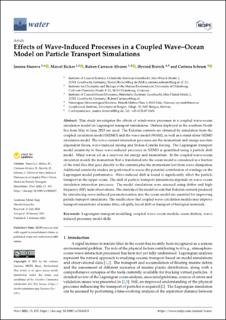| dc.contributor.author | Staneva, Joanna | |
| dc.contributor.author | Ricker, Marcel | |
| dc.contributor.author | Alvarez, Ruben Carrasco | |
| dc.contributor.author | Breivik, Øyvind | |
| dc.contributor.author | Schrum, Corinna | |
| dc.date.accessioned | 2022-04-26T08:05:26Z | |
| dc.date.available | 2022-04-26T08:05:26Z | |
| dc.date.created | 2021-07-13T15:20:56Z | |
| dc.date.issued | 2021 | |
| dc.identifier.issn | 2073-4441 | |
| dc.identifier.uri | https://hdl.handle.net/11250/2992710 | |
| dc.description.abstract | This study investigates the effects of wind–wave processes in a coupled wave–ocean circulation model on Lagrangian transport simulations. Drifters deployed in the southern North Sea from May to June 2015 are used. The Eulerian currents are obtained by simulation from the coupled circulation model (NEMO) and the wave model (WAM), as well as a stand-alone NEMO circulation model. The wave–current interaction processes are the momentum and energy sea state dependent fluxes, wave-induced mixing and Stokes–Coriolis forcing. The Lagrangian transport model sensitivity to these wave-induced processes in NEMO is quantified using a particle drift model. Wind waves act as a reservoir for energy and momentum. In the coupled wave–ocean circulation model, the momentum that is transferred into the ocean model is considered as a fraction of the total flux that goes directly to the currents plus the momentum lost from wave dissipation. Additional sensitivity studies are performed to assess the potential contribution of windage on the Lagrangian model performance. Wave-induced drift is found to significantly affect the particle transport in the upper ocean. The skill of particle transport simulations depends on wave–ocean circulation interaction processes. The model simulations were assessed using drifter and high-frequency (HF) radar observations. The analysis of the model reveals that Eulerian currents produced by introducing wave-induced parameterization into the ocean model are essential for improving particle transport simulations. The results show that coupled wave–circulation models may improve transport simulations of marine litter, oil spills, larval drift or transport of biological materials. | en_US |
| dc.language.iso | eng | en_US |
| dc.publisher | MDPI | en_US |
| dc.rights | Navngivelse 4.0 Internasjonal | * |
| dc.rights.uri | http://creativecommons.org/licenses/by/4.0/deed.no | * |
| dc.title | Effects of wave-induced processes in a coupled wave-ocean model on particle transport simulations | en_US |
| dc.type | Journal article | en_US |
| dc.type | Peer reviewed | en_US |
| dc.description.version | publishedVersion | en_US |
| dc.rights.holder | Copyright 2021 by the authors | en_US |
| dc.source.articlenumber | 415 | en_US |
| cristin.ispublished | true | |
| cristin.fulltext | original | |
| cristin.qualitycode | 1 | |
| dc.identifier.doi | 10.3390/w13040415 | |
| dc.identifier.cristin | 1921599 | |
| dc.source.journal | Water | en_US |
| dc.relation.project | Norges forskningsråd: 237906 | en_US |
| dc.relation.project | Norges forskningsråd: 244262 | en_US |
| dc.relation.project | Copernicus-programmet: CMEMS / WaveFlow Service Evolution | en_US |
| dc.identifier.citation | Water. 2021, 13 (4), 415. | en_US |
| dc.source.volume | 13 | en_US |
| dc.source.issue | 4 | en_US |

